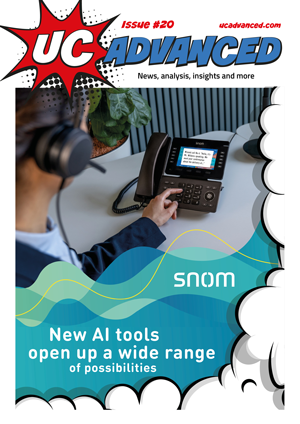Communication is still key according to Martin Taylor, Co-Founder and Deputy CEO of Content Guru
Modern business is built on customer interactions. Establishing and building relationships with a loyal customer base through providing an excellent customer experience (CX) is essential to any organisation seeking to survive and thrive. Whether through phone, email, chat, social media, SMS or other ways of communicating, businesses need 24/7 omnichannel availability, via the customer’s communication channel of choice. With almost half of customers now preferring to solve their queries using digital, social and self-service methods, consumer demands for digital interactions are only going to grow louder and more insistent.
Interactions between companies and customers through digital channels are on the rise, with 92% of CX leaders predicting digital self-service interactions to increase more than any other engagement channel this year. It is therefore perhaps unsurprising that increasing the use of digital channels is the top priority for 85% of organisations before 2025.
Despite advances in communications technology, many businesses still rely on legacy on-premise solutions, built using outdated telephony-era infrastructure that simply won’t meet the demands of modern consumers. How can CX professionals stay on track and embrace technology to deliver exceptional customer experiences consistently?
By adopting a cloud-focussed omnichannel approach, businesses can enhance customer experiences, streamline communication processes and stay ahead in the competitive landscape of customer communications. A cloud-focussed approach allows brands to adapt and meet needs more effectively – here are some of the areas in which such an approach can ‘win’.
Omnichannel Capabilities
Customers want outstanding, authentic and consistent digital experiences. Businesses that integrate with multiple self-service, digital, social and voice channels, whilst retaining and displaying previous customer interactions, have a CX advantage. Gone are the days of voice-only call centres, where customers waited on the phone in long queues to find an answer to their query. With omnichannel, whenever a customer calls, emails, texts, or interacts with a business using a chatbot, the experience is consistent, on-brand and centred around the consumer’s channel of choice. This approach increases the chances of achieving first-contact resolution (FCR), as well as saving time on both sides of the transaction.
It should come as no surprise, then, that organisations are prioritising omnichannel capabilities in their CX strategy, with the number of businesses investing in omnichannel CX quadrupling pre-pandemic, and then continuing to grow ever since. On-premise, disjointed solutions struggle to maintain seamless omnichannel capability, leading to uneven customer journeys and poor CX. On the other hand, omnichannel cloud contact centres support cohesive integration between different channels, without requiring additional solutions, allowing customers to leverage multiple channels of their choice.
Artificial intelligence (AI) makes delivering great CX even easier. With AI, customers can begin their interaction through one channel, such as a call or messaging via an AI-enabled chatbot. Natural Language Processing can semantically analyse the nature and sentiment of a query and route the customer to the right end-point seamlessly, such as the best available human agent to resolve a complex query, or a self-service platform for more straightforward questions.
Integration, Integration, Integration
Legacy, disjointed on-premise solutions place the onus of building, maintaining and managing integrations on the organisation, which can lead to progressively more complex and rigid systems that are a struggle to update and are incapable of morphing to meet future customer demands.
Almost half of businesses consider better integration of their omnichannel CX strategy as their primary goal for 2023. With an omnichannel cloud contact centre solution, businesses don’t need to worry about configuring and maintaining integrations to fit with existing systems. Instead they can focus instead on overlaying their systems of record using no-code tools and simply delivering great CX. Integrations, in the form of Application Programming Interfaces (APIs), enable agents to access instantly a customer’s details from one or more Customer Relationship Management (CRM) systems, collaboration platforms such as Microsoft Teams, or other third-party systems of record. This increases the efficiency of interactions and saves time and effort on the part of both the customer and the service agent.
The flexibility of cloud solutions means businesses ensure that customers’ demands for future channels of engagement can be met. Future updates can adapt to new interaction channels, such as integrations with AI chatbots, and asynchronous messaging channels such as WhatsApp and voice notes, helping to maintain a seamless modern customer journey.
Limitless Scalability
When demand surges, businesses often respond with longer wait times, generating abandoned calls as customers are fobbed off with messages asking them to call another time. No organisation wants to deliver this level of CX, but many are forced to; constrained by the bottlenecks in their on-premise technology. As a result, organisations struggle to handle peak demand, which ultimately frustrates those trying to seek assistance, and in an age of limited brand loyalty.
Cloud-based solutions rapidly increase capacity when required, whether due to predictable demand, such as a scheduled event, or the unexpected influxes of disaster-driven demand. Unlike their on-premise predecessors, cloud contact centre solutions can be operated from anywhere with an internet connection. This makes adding new agents in response to rising demand – including home-based agents – easy and flexible. Demand forecasts can predict the number of agents required to meet surges, scheduling shifts and breaks around the demands of the situation.
Cloud-based scalability also benefits the employee experience. With 62% of companies looking to build more opportunities to work remotely into their contact centre environment, cloud solutions enable organisations to add agents in different geographic locations, offering the flexibility of hybrid or remote working every day. Agent retention is boosted by flexible hybrid contracts that aid work-life balance, and global organisations benefit from agents working across multiple time zones and supporting customers 24/7.
Overcoming the hurdles of legacy technology leads to scalable, reliable and integrated communications between customers and businesses. Customers benefit from seamless omnichannel CX with reduced wait times, while businesses benefit from AI-assisted efficiencies and hybrid working capabilities. Migration to the cloud helps businesses leave behind outdated on-premise technology and deliver first-class CX whenever and from wherever.










